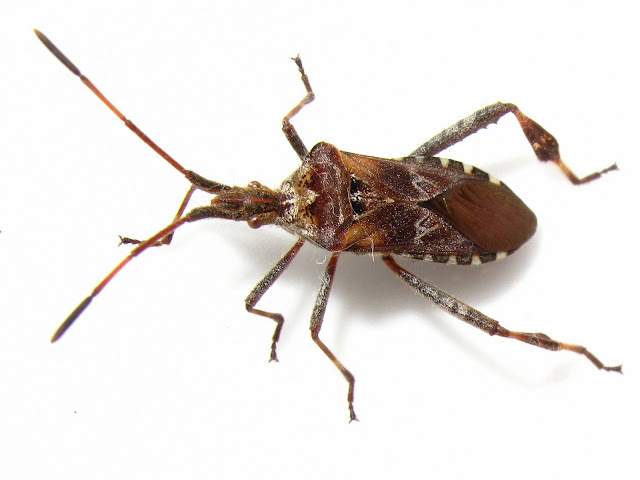
This large, striking bug entered the house at night through an opened window. It is the alien species
Leptoglossus occidentalis, the Western Conifer Seed Bug, a native from western North America, where is a minor pest of conifers. This species has long antennae and large rear legs, a pale zig-zag mark on the wings, and distinctly flattened and enlarged tibia, which gives the name to its group, the leaf-footed bugs. During last century, this species spread across North America and during the last decade has also been introduced in Europe, where it has quickly spread from the initial introduction point in Italy. It was accidentally transported in timber, and its spread could also possibly been aided by Christmas tree shipments. Nymphs and adults feed on the sap of cone seeds and buds, and therefore the damage is restricted to seed production. In continental Europe, where there are established populations, it does not appear to cause much damage. Every now and then, there are migratory influxes to the U.K. from the continent, as occurred in 2008. The bug often falls in moth traps, and is a good flyer. It is most obvious in the autumn, when it moves about looking for suitable hibernation sites, often entering buildings and sometimes forming large aggregations, attracted by pheromones produced by males. Nymphs have been found in a few sites in the U.K., so it appears to be establishing.
If you have seen this bug, you can report it
here.
References
Lis, Jerzy A., Barbara Lis & Jerzy Gubernator (2008). Will the invasive western conifer seed bug Leptoglossus occidentalis Heidemann (Hemiptera: Heteroptera: Coreidae) seize all of Europe? Zootaxa, 1740, 68-68
Taylor, S.J., G. Tescari & M. Villa (2001). A nearctic pest of Pinaceae accidentally introduced into Europe: Leptoglossus occidentalis (Heteroptera: Coreidae) in Northern Italy. Entomological News, 112, 101-103.
Blatt, S. & Borden, J. (1996). Evidence for a male-produced aggregation pheromone in the Western Conifer Seed Bug, Leptoglossus occidentalis Heidemann (Hemiptera: Coreidae) The Canadian Entomologist, 128 (4), 777-778 DOI: 10.4039/Ent128777-4


4 comments:
I hadn't realised they had got this far North.
I haven't seen any ...yet.
Hi Ray, I guess that it was sheer luck. It must have been attracted to the night light we keep in the corridor, and due to the hot weather, the windows were open. A beautiful beast!
Can anyone tell me how far a single seed bug can fly? If we cleared the cones from the ground near our cabin, does that help at all? They really infiltrated the cabin last fall....
Saw one today in Ottawa Ontario
Post a Comment